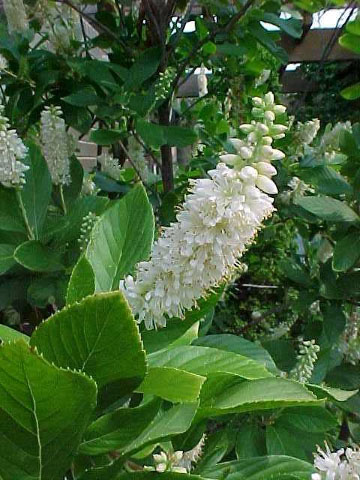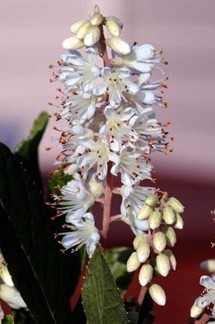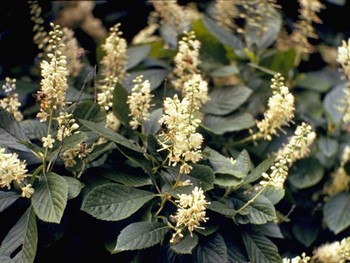Clethra alnifolia: Sweet Pepperbush
Latin name: Clethra alnifolia
Common name: Summersweet Clethra
Flowers: Showy, fragrant white/pink flowers that occur in 2-6” racemes 8
Fruit or cones: Showy, brown, persists through winter 10,8
Height & Width: 3-8’ ft. high, variable spread 8
Type: Deciduous 12
Habit: Densely rounded shrub and often suckering, resulting in large colonies 8
Wetland indicator category**: FAC, FACW 17
Texture: Coarse 16
Growth rate: Moderate 16
Light: Full sun to part shade, tolerates heavy shade 12
Moisture: High, yet drought tolerant 12
Soil*: Provide acid (pH<6.8), moist, well- drained soils 10,12
Zones: 4 to 9 8
Origin: United States east coast, Maine to Florida to coastal Texas 8,16
Ecosystem benefits: Ornamental, fragrant, outstanding fall color; bees, butterflies, and hummingbirds use flowers; provides food for wildlife 10
Features: This shrub is an amazingly adaptable plant 8. It is very ornamental and fragrant, with outstanding fall color. It attracts bees, butterflies, and hummingbirds and provide food for some mammals 10. Offers multiple seasons of interest with its spring foliage, summer blooms, yellow fall color, and exfoliating bark in winter 7.
Siting: Great choice in a shrub border, along streams and ponds, or in large masses by the edge of woodlands 8.
Care: Plant so root flare is visible at soil surface 14. At planting, water the root ball daily with two gallons of water per inch of trunk diameter for two weeks, every other day for two months and then weekly until established. Modify water recommendations to reflect site drainage and rainfall. Apply 3” of mulch over the planted area. Do not allow mulch to touch the trunk 14.
Pests: Damage caused by spider mites can be severe on plants in hot, dry locations 16. Plants are relatively pest resistant if cultural preferences are met 10,12.
- USDA SC Invasive Plant Species Web site at http://www.invasivespeciesinfo.gov/plants/main.shtml
- SC Exotic Plant Pest Council Web site at http://www.se-eppc.org/southcarolina/
Author: Owen Lancaster
Sources:
- Armitage, A. (2001). Armitage’s manual of annuals, biennials, and half-hardy perennials. Portland, OR: Timber Press.
- Armitage, A. (2006). Armitage’s native plants for North American gardens. Portland, Oregon: Timber Press.
- Armitage, A. (2008). Herbaceous perennial plants: A treatise on their identification, culture, and garden attributes. Athens, GA: University of Georgia.
- Clemson Cooperative Extension Home and Garden Information Center.(2011). Flowers fact sheets. Retrieved from https://hgic.clemson.edu/category/flowers/
- Clemson Cooperative Extension Home and Garden Information Center.(2011). Groundcovers & vines fact sheets. Retrieved from https://hgic.clemson.edu/category/groundcovers/
- Clemson Cooperative Extension Home and Garden Information Center.(2011). Trees. Retrieved from https://hgic.clemson.edu/category/trees/
- Clemson Cooperative Extension Home and Garden Information Center.(2011). Shrubs. Retrieved from https://hgic.clemson.edu/category/shrubs/
- Dirr, M. A. (2009). Manual of woody landscape plants. Champaign, IL: Stipes Publishing.
- Gilman, E. F. (1997). Trees for urban and suburban landscapes. Albany, NY: Delmar Publishers.
- Lady Bird Johnson Wildflower Center University of Texas at Austin. (2012). Native plant information network. Retrieved from http://www.wildflower.org/explore/
- McMillan, P., Plant taxonomist Clemson University, personal communication.
- Missouri Botanical Garden Kemper Center for Home Gardening. Plant finder. Retrieved from http://www.mobot.org/gardeninghelp/plantfinder/Alpha.asp
- North Carolina State University (2005). Plant fact sheets. Retrieved from http://www.ces.ncsu.edu/depts/hort/consumer/factsheets/index.html
- Strother, E. V., Ham, D. L., Gilland, L. (2003) Urban tree species guide: Choosing the right tree for the right place. Columbia, SC: South Carolina Forestry Commission.
- University of Florida, IFAS Extension. (2011). Southern trees fact sheet. Retrieved from http://edis.ifas.ufl.edu/department_envhort-trees
- USDA . Plant profile. (n/d).Retrieved from http://plants.usda.gov/java/
- USDA. Plant wetland indicator status. (n/d). Retrieved from http://plants.usda.gov/wetland.html
- Vincent, E., Environmental horticulturist Clemson University, personal communication.
- Clemson Extension. Carolina Yards Plant Database. Retrieved from https://www.clemson.edu/extension/carolinayards/plant-database/index.html
*Soil pH is determined using a professional soil test. Contact your Clemson University County Extension service for assistance www.clemson.edu/extension/. Click on “local offices”.
**2012 Plant Wetland Indicator categories (quantitative derived) http://plants.usda.gov/wetinfo.html
|
Indicator Code |
Indicator Status |
Comment |
|
OBL |
Obligate Wetland |
Almost always is a hydrophyte, rarely in uplands |
|
FACW |
Facultative Wetland |
Usually is a hydrophyte but occasionally found in uplands |
|
FAC |
Facultative |
Commonly occurs as either a hydrophyte or non-hydrophyte |
|
FACU |
Facultative Upland |
Occasionally is a hydrophyte but usually occurs in uplands |
|
UPL |
Obligate Upland |
Rarely is a hydrophyte, almost always in uplands |
Latin name: Clethra alnifolia
Common name: Sweet Pepperbush
Flowers: White, 2-6” spikes, blooms July - August 10,12
Fruit or cones: Dark brown seed capsules with 1/8” diameter 12
Height & Width: 3-8ft tall, 4-6ft wide 10,12
Type: Deciduous shrub 10,12
Habit: Shrub 10,12
Wetland indicator category**: FAC, FACW 17
Texture: Medium 20
Growth rate: Medium 19
Light: Full sun to part shade 10,12
Moisture: Wet - moist 10
Soil*: Ph< 6.8, sand and clay soils 10
Zones: 3 to 9 12
Origin: Native to the lower 48 states 10
Ecosystem benefits: Attracts bees, hummingbirds, and butterflies with flowers. Other mammals eat the fruit 10,12.
Features: The flowers of this shrub an aesthetically pleasing and are beneficial because they attract hummingbirds, bees, and butterflies. The fruit of this shrub also provide food for some mammals. This shrub offers multiple seasons of interest with summer blooms, spring foliage, yellow fall color, and exfoliating bark in the winter 10,12.
Siting: This shrub would do well in a raingarden or a spot in the yard that has a high content of sand and clay that stays moist 12.
Care: Plant so root flare is visible at soil surface 14. At planting, water the root ball daily with two gallons of water per inch of trunk diameter for two weeks, every other day for two months and then weekly until established. Modify water recommendations to reflect site drainage and rainfall. Apply 3” of mulch over the planted area. Do not allow mulch to touch the trunk 14.
Pests: Plants are relatively pest resistant if cultural preferences are met 10,12.
This plant does not appear on the following invasive plant lists on 3/2/2020:
USDA SC Invasive Plant Species
SC Exotic Plant Pest Council
Author: Cy Gettliffe
Sources:
- Armitage, A. (2001). Armitage’s manual of annuals, biennials, and half-hardy perennials. Portland, OR: Timber Press.
- Armitage, A. (2006). Armitage’s native plants for North American gardens. Portland, Oregon: Timber Press.
- Armitage, A. (2008). Herbaceous perennial plants: A treatise on their identification, culture, and garden attributes. Athens, GA: University of Georgia.
- Clemson Cooperative Extension Home and Garden Information Center.(2011). Flowers fact sheets. Retrieved from https://hgic.clemson.edu/category/flowers/
- Clemson Cooperative Extension Home and Garden Information Center.(2011). Groundcovers & vines fact sheets. Retrieved from https://hgic.clemson.edu/category/groundcovers/
- Clemson Cooperative Extension Home and Garden Information Center.(2011). Trees. Retrieved from https://hgic.clemson.edu/category/trees/
- Clemson Cooperative Extension Home and Garden Information Center.(2011). Shrubs. Retrieved from https://hgic.clemson.edu/category/shrubs/
- Dirr, M. A. (2009). Manual of woody landscape plants. Champaign, IL: Stipes Publishing.
- Gilman, E. F. (1997). Trees for urban and suburban landscapes. Albany, NY: Delmar Publishers.
- Lady Bird Johnson Wildflower Center University of Texas at Austin. (2012). Native plant information network. Retrieved from http://www.wildflower.org/explore/
- McMillan, P., Plant taxonomist Clemson University, personal communication.
- Missouri Botanical Garden Kemper Center for Home Gardening. Plant finder. Retrieved from http://www.mobot.org/gardeninghelp/plantfinder/Alpha.asp
- North Carolina State University (2005). Plant fact sheets. Retrieved from http://www.ces.ncsu.edu/depts/hort/consumer/factsheets/index.html
- Strother, E. V., Ham, D. L., Gilland, L. (2003) Urban tree species guide: Choosing the right tree for the right place. Columbia, SC: South Carolina Forestry Commission.
- University of Florida, IFAS Extension. (2011). Southern trees fact sheet. Retrieved from http://edis.ifas.ufl.edu/department_envhort-trees
- USDA . Plant profile. (n/d).Retrieved from http://plants.usda.gov/java/
- USDA. Plant wetland indicator status. (n/d). Retrieved from http://plants.usda.gov/wetland.html
- Vincent, E., Environmental horticulturist Clemson University, personal communication.
- Clemson Extension. Carolina Yards Plant Database. Retrieved from https://www.clemson.edu/extension/carolinayards/plant-database/index.htm
- Gettliffe, C., Senior student of Horticulture, Clemson University, personal knowledge.
*Soil pH is determined using a professional soil test. Contact your Clemson University County Extension service for assistance www.clemson.edu/extension/. Click on “local offices”.
**2012 Plant Wetland Indicator categories (quantitative derived) http://plants.usda.gov/wetinfo.html
| Indicator Code | Indicator Status | Comment |
|---|---|---|
| OBL | Obligate Wetland | Almost always is a hydrophyte, rarely in uplands |
| FACW | Facultative Wetland | Usually is a hydrophyte but occasionally found in uplands |
| FAC | Facultative | Commonly occurs as either a hydrophyte or non-hydrophyte |
| FACU | Facultative Upland | Occasionally is a hydrophyte but usually occurs in uplands |
| UPL | Obligate Upland | Rarely is a hydrophyte, almost always in uplands |

 Source:
Source: Source:
Source:  Source:
Source: